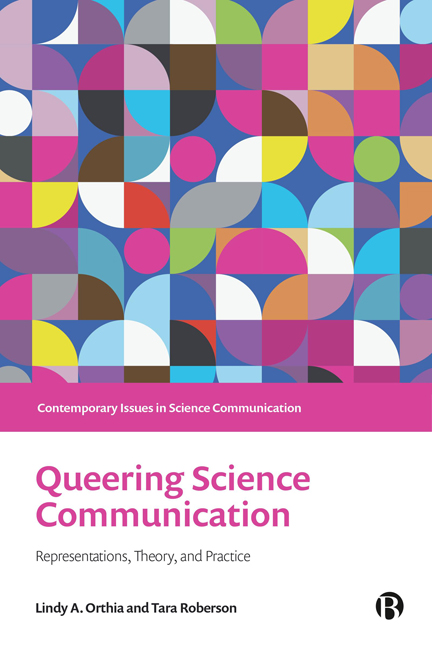Book contents
- Frontmatter
- Contents
- Series Editor Preface
- Notes on Contributors
- Acknowledgements
- Terminology and Sensitive Content in This Book
- Introduction
- PART I Negotiating Queer Identities with Science, Technology, and Medicine
- PART II Representations of Queerness in Public Science Communication
- PART III Queer People in Science Communication Communities
- PART IV Queering Institutional Science Communication Agendas
- Conclusions
- Index
7 - Including Queerness and Improving Belonging of Intersectional Queer Identities in Science Communication Communities
Published online by Cambridge University Press: 18 January 2024
- Frontmatter
- Contents
- Series Editor Preface
- Notes on Contributors
- Acknowledgements
- Terminology and Sensitive Content in This Book
- Introduction
- PART I Negotiating Queer Identities with Science, Technology, and Medicine
- PART II Representations of Queerness in Public Science Communication
- PART III Queer People in Science Communication Communities
- PART IV Queering Institutional Science Communication Agendas
- Conclusions
- Index
Summary
“Are there any other identities that are important to you that I haven't asked you about today?” I asked.
“I’m a lesbian,” she declared with a soft smile, which I involuntarily reciprocated.
I felt a sense of simultaneous calm and excitement overwhelm as those words hung in the air and we closed out the video interview. While past interviewees had shared their LGBTIQA+ identities when asked this question, this time it resonated with me differently, reinforcing my sense of self and queer belonging in science communication. Researching efforts at building inclusive science communication (ISC) research and practice revealed that many of the leaders in this movement had numerous marginalized identities of which they live at the intersection. The ISC movement was a space where they both passively and actively were their full selves, in research, practice, and – simply – life.
This conversation exemplified a larger trend in the strengths and struggles of existing efforts at addressing inclusion in science communication and science, technology, engineering, and mathematics (STEM). Increasingly, organizations and lab groups are taking a holistic approach to equitable science communication and addressing common exclusionary practices (Judd and McKinnon, 2021). Despite this notable effort to meaningfully support inclusion among some axes of identity, a remaining challenge is creating science communication communities that are radically and intentionally inclusive of queerness. This chapter seeks to briefly present how this came to be and provide recommendations for how we might build science communication communities that are inclusive of intersectional queer identities moving forward. It focuses specifically on mobilizing communities in alignment with the importance of shared experiences and identity, relationship building, and self-efficacy to create social change (Orthia et al, 2021).
In this chapter, references to queerness may encompass aspects of sexuality, gender, and variations in sex characteristics, recognizing that these are distinct elements of identity, and yet also how the queer community aspires to include all people who have identities that are not binary-cisgender and/or heterosexual (Yoder and Mattheis, 2016).
Queerness in STEM and science communication Communities
The STEM fields have been making nominal efforts towards equity for 50 years. Early conversations focused specifically on race and ethnic diversity in the STEM fields (Gillette, 1972) and – later – binary gender inequality without addressing queerness (Hanson et al, 1996; Settles et al, 2006).
- Type
- Chapter
- Information
- Queering Science CommunicationRepresentations, Theory, and Practice, pp. 129 - 143Publisher: Bristol University PressPrint publication year: 2023

